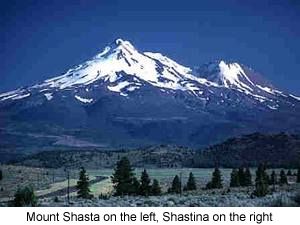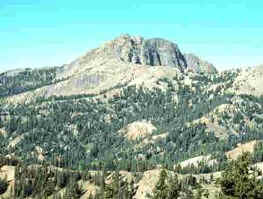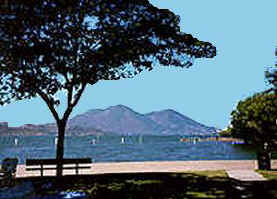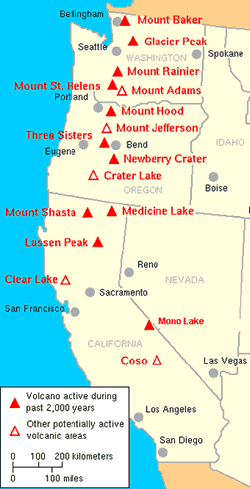BACKGROUND:
 Volcanoes produce different types of volcanic rocks.
The creation of volcanic rocks depends on the type of eruption and the
source and composition of the magma erupted. The variety of volcanic rocks
can range from ash to rocks with small minerals in them. Geologists describe
volcanic rocks by their appearance and mineral composition. They examine
both hand specimens, and usually make "thin sections", very thin
slices of rock that they can examine under the microscope. They then name
rocks based on their observations. For example, basalt (a dark gray to black
rock) contains more minerals of olivine and hornblende than andesite (a gray
rock). Andesite may contain quartz but basalt will not. A volcanic rock that
had gas discharged with the eruption may have "holes" within the
rock (called vesicles) while a quiet lava flow would not have such gas
bubble holes. Some volcanic rocks start cooling inside the magma chamber,
forming some larger minerals. When the volcano erupts, it brings up these
larger minerals, as well as other lava which then cools into smaller
crystals. In a hand sample of this kind of rock, you would see large
minerals embedded in a dark matrix of smaller minerals that would require a
microscope to see. Obviously, the naming of igneous rocks is complex. This
lab begins to expose students to naming igneous rocks. Volcanoes produce different types of volcanic rocks.
The creation of volcanic rocks depends on the type of eruption and the
source and composition of the magma erupted. The variety of volcanic rocks
can range from ash to rocks with small minerals in them. Geologists describe
volcanic rocks by their appearance and mineral composition. They examine
both hand specimens, and usually make "thin sections", very thin
slices of rock that they can examine under the microscope. They then name
rocks based on their observations. For example, basalt (a dark gray to black
rock) contains more minerals of olivine and hornblende than andesite (a gray
rock). Andesite may contain quartz but basalt will not. A volcanic rock that
had gas discharged with the eruption may have "holes" within the
rock (called vesicles) while a quiet lava flow would not have such gas
bubble holes. Some volcanic rocks start cooling inside the magma chamber,
forming some larger minerals. When the volcano erupts, it brings up these
larger minerals, as well as other lava which then cools into smaller
crystals. In a hand sample of this kind of rock, you would see large
minerals embedded in a dark matrix of smaller minerals that would require a
microscope to see. Obviously, the naming of igneous rocks is complex. This
lab begins to expose students to naming igneous rocks.
|

Mount Lassen in northern California
|

Clear Lake near the city of Clearlake
|
Although volcanoes can be close to each other, they
may have different types of rocks. In this lab the students look at
volcanics from Mt. Lassen, Mt. Shasta, Mono Craters, and Clearlake, which
are all located in California.
 PROCEDURE: PROCEDURE:
- Discuss
with students all the different types of volcanic rocks that can form
from volcanoes.
- Locate the following areas where California volcanic rocks can be
found: Mt. Lassen, Mt. Shasta, Clearlake, and Mono Lake (all in northern
California). Explain that the Mt. Lassen, Mt. Shasta and Mono Craters
volcanoes are sleeping (dormant volcanoes), and that the Clearlake
volcanics are no longer active (extinct volcano).
- Instruct students to look at their igneous rock samples and describe
them. Tell the students to use words like "black, gray, heavy,
glassy, can see minerals", or any other descriptive terms. All of
the specimens form a specific locality may not look exactly the same.
The students' descriptions should reflect what they observe in the
individual samples. Have them record their descriptions on the
worksheet.
- Make a composite class description of the rocks. The descriptions
should reflect a difference between the rock types. For example, samples
from Mt. Lassen and Mt. Shasta should be heavier rocks and have many
more visible minerals than those from Clear Lake or Mono Craters. The
Clear Lake sample is obsidian and Mono Crater sample is a light pumice.
Compare the samples as follows:
| Clearlake |
Mono Craters |
Mt. Lassen |
Mt. Shasta |
black
glassy |
light color
"holey" |
gray
can see minerals |
reddish
"holey" |
- Next, have the students make a small model of Mt. Lassen using clay.
Mt. Lassen is a composite volcano, composed of lava and ash layers. Use
the presentation to help them construct the clay model. The diagram on
the lab sheet gives the students clues for making the model. Make sure
that they include a crater and a slope which is appropriate for a normal
composite volcano. Students will use this model in the HAZARDS
lab.
|